About every 2-3 years, a new version of Bluetooth comes out. The latest Bluetooth 5.4 promises a more reliable connection with greater energy efficiency than version 5.3.
But what does that mean for wireless audio quality, and should you even upgrade? Here’s everything you need to know about wireless Bluetooth technology in headphones.
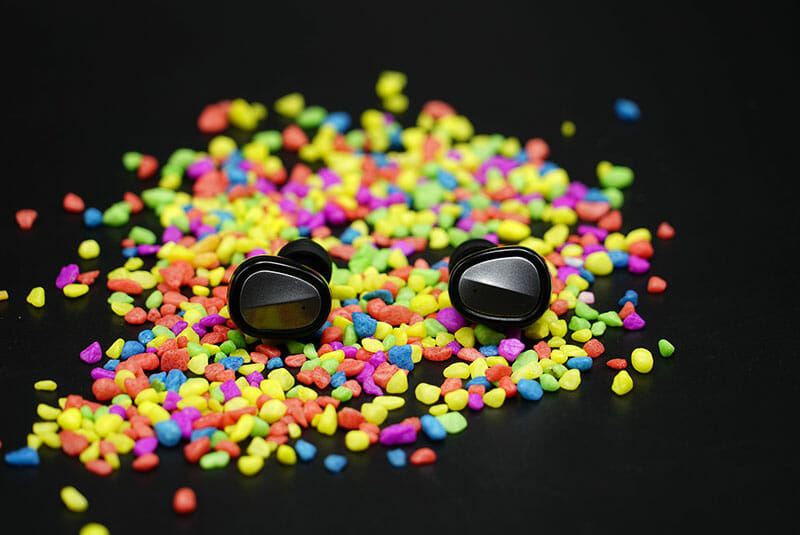
- Bluetooth 5.4 is the latest Bluetooth version, bringing higher security and efficient connectivity to thousands of low-energy nodes.
- Only the major upgrades brought data transmission speed improvements, while incremental upgrades mostly tackle security and minor efficiency boosts.
- Audio quality transmitted via Bluetooth is really high when using LDAC, LHDC, or aptX HD/Lossless, but it’s still lossy.
- The First Bluetooth headsets were displayed in 1999, the same year as SIG released Bluetooth 1.0.
The Latest Bluetooth Versions
In the past years, we got 5 different versions of Bluetooth: 5.0, 5.1, 5.2, 5.3, and 5.4.
| Bluetooth 5.0 | Bluetooth 5.1 | Bluetooth 5.2 | Bluetooth 5.3 | Bluetooth 5.4 | |
|---|---|---|---|---|---|
| Range | Up to 800 feet (240 meters) | Same | Same | Same | Same |
| Speed | 2 Mbps (LE) 50 Mbps (EDR) | Same | Same | Same | Same |
| Energy efficiency | Good | Great | Great | Excellent | Excellent |
| Reliability | Good | Great | Great | Excellent | Excellent |
| Security | Great | Great | Great | Great | Excellent |
Bluetooth 5.4
What’s new in Bluetooth 5.4?
Periodic Advertising with Responses
- Ability to bi-directionally communicate with multiple extremely low-powered devices from a single central device.
Until now, an access point couldn’t communicate bi-directionally with multiple low-powered end nodes. With Bluetooth 5.4, the access point can communicate with thousands of end nodes.
An example where this feature might come in handy is in retail. If the store is using electronic shelf labels (prices under the items), they can now update them wirelessly to avoid manual labor.

Encrypted Advertising Data
- A more secure communication between two devices.
Along with data encryption, Bluetooth 5.4 also allows the encryption of advertising data. However, both devices need to be previously connected to exchange the session key.
Bluetooth 5.3
Channel Classification enhancement
- A more reliable connection between two devices with fewer stutters.
Previously, the transmitting device decided on which channels it wanted to transmit data. However, not all channels are ideal, leading to data packet errors due to interference.
Now both devices that support Bluetooth 5.3 agree on what channels are the best for both to ensure a more reliable connection, especially at long range.
Periodic Advertising enhancement
- More optimized wireless communication between two devices that results in lower power consumption.
To ensure that the receiving device gets all the data, the transmitting device sends multiple identical packets. The controller on the receiving device then recognizes which data it has already received.
However, with the new Bluetooth version 5.3, that data isn’t sent back to the host, but it’s instead filtered out. The end result is slightly lower power consumption.

Connection Subrating
- Faster switching between how hard the Bluetooth antenna has to work results in lower power consumption.
Bluetooth 5.3 enables your devices to quickly switch between high and low-duty cycles (using more or less bandwidth).
That comes in handy when you’re listening to music on your headphones and receive a phone call. The transition is now faster, with lower latency and lower energy consumption.
Bluetooth 5.2
LE Audio (LC3 Bluetooth codec)
- New Bluetooth audio codec with improved audio quality while using less data.
This is a new generation of low-energy audio that expands on existing functions. It offers variable (and higher) transfer speeds while keeping power consumption down.
The secret is in much more efficient compression on the transmitting side and decompression on receiving side. The new Bluetooth codec will replace SBC as a new standard.
Enhanced attribute protocol
- Less back-and-forth communication means lower latency (less audio lag).
Previously, multiple apps on a transmitting device communicated with a receiving device in a sequential manner (when one is speaking, others are blocked).
With Bluetooth 5.2, they can do it simultaneously.
Isochronous channels
- Ability to connect to a source and raise loudness independently and choose different language audio when watching TV without affecting other viewers.
This feature allows you to connect your headphones to multiple devices at once and seamlessly switch between each other.
Meaning if you’re listening to TV via Bluetooth and someone phone calls, headphones will automatically switch to your phone.
Furthermore, it will help users with hearing aids. It allows audio sharing from a TV, giving you the option to boost loudness independently. That way, you don’t bother everyone around with loud TV.

Potentially, you will even walk into a bar, see a football match on a TV, and tune your headphones to a specific channel to hear a commentator more clearly.
Listeners will have the ability to select commentators in different languages (if the audio stream contains such data).
There’s also support for multiple audio broadcasting to different headphones. You can even send different audio streams to the left or right wireless earbud.
Bluetooth 5.1
Accurate location tracking
- Saving energy by more accurate tracking of the receiving device.
Version 5.1 requires having more antennas placed around a transmitting device. By checking the Bluetooth signal strength in each antenna (“angle of arrival” and “angle of departure”), it can more accurately determine the location of receiving device.
This feature comes in handy for tracking lost gadgets and saving energy by avoiding transmitting signals in all directions.
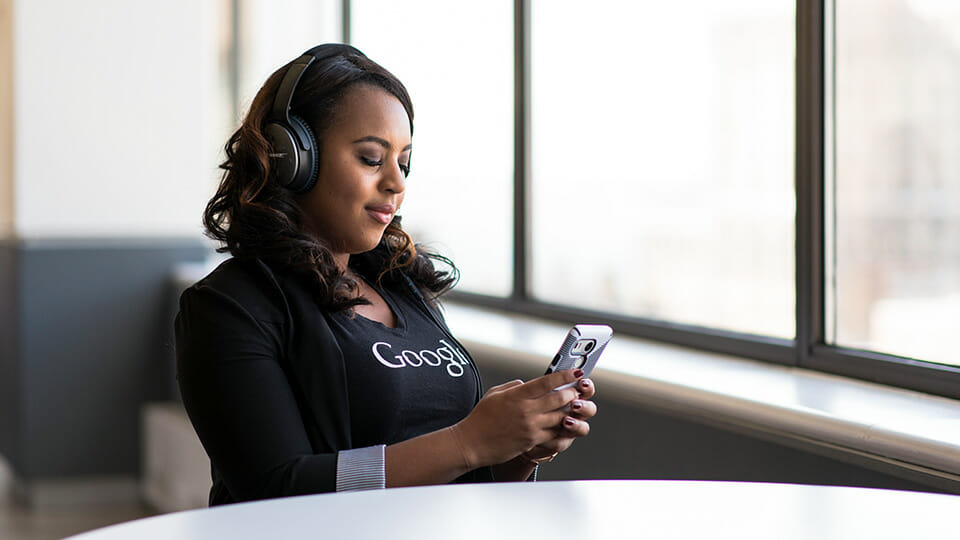
GATT caching
- Quicker pairing process with Bluetooth devices that you’ve previously paired to.
GATT caching speeds up the process of pairing two Bluetooth-enabled devices that were previously already connected. Since they already know their pairing information, they skip the identification procedure. As a result, they save on battery.
Connection advertising
- Faster pairing process and a more stable Bluetooth connection.
Two things are new: “randomized advertising channel indexing” and “periodic advertising sync transfer.”
The first one is a way Bluetooth cycles between channels.
Since Bluetooth runs on the 2.4GHz frequency, each wireless device uses channels to avoid interferences.
Previously, it cycled in exact order. With Bluetooth 5.1, it picks up the channel randomly, which improves connection stability.
The second feature gives all Bluetooth devices in your home the ability to share advertising schedules. That makes pairing faster, even with new devices.
You can read a more detailed comparison between Bluetooth 5.0 and 5.1 here.
Bluetooth 5.0
BLE (Bluetooth Low Energy)
- Both connected devices consume less energy when not transmitting lots of data (like when listening to music).
This feature was already available in Bluetooth 4.0 for trackers, but with Bluetooth 5.0, you can also use it with headphones. That means lower power consumption on both transmitting and receiving devices.
Wider Bluetooth range
The four-times wider range over the previous generation means that, theoretically, Bluetooth 5.0 can reach up to 800 feet (240 meters) in radius.

Higher transfer speeds
Data transfer doubled, from 1Mbps to 2Mbps. That comes in handy for Dual Audio features and high-res audio.
Dual Audio
Now you can connect two audio devices and use them at the same time. You can either connect two headphones or two speakers (creating stereo mode).
Bluetooth Version Differences
Bluetooth was invented in 1999 when the first wireless headset with Bluetooth 1.0 came to the market. The technology was revolutionary as it enabled users to wireless share data between devices rather than using cables.
The technology was impressive because it needed less energy to work, so you could easily run it on battery-powered devices. However, the first Bluetooth versions were unreliable and very slow by today’s standards.
Bluetooth 1.0
Bluetooth 1.0, or Bluetooth Classic, originates in July 1999 and offers a new way of wirelessly transferring data. First-ever Bluetooth maxed out at 732kbps and offered a maximum connection range of 33 feet (or 10 meters).
Bluetooth 1.1
A small upgrade from February 2001 mostly improved security, reinforcing the encryption of the transferred data. It also ensures your device was more easily discovered and paired to.
Bluetooth 1.2
In November 2003, made a small but important improvement in data transfer speeds, raising it to 1Mbps. It also added Extended Synchronous Connections and Adaptive Frequency Hopping to its feature list, improving the voice and connection quality.
- Bluetooth 1.0 enabled a more energy efficient wireless connectivity on the go.
- Low maximum data transfer rate meant very poor audio quality.
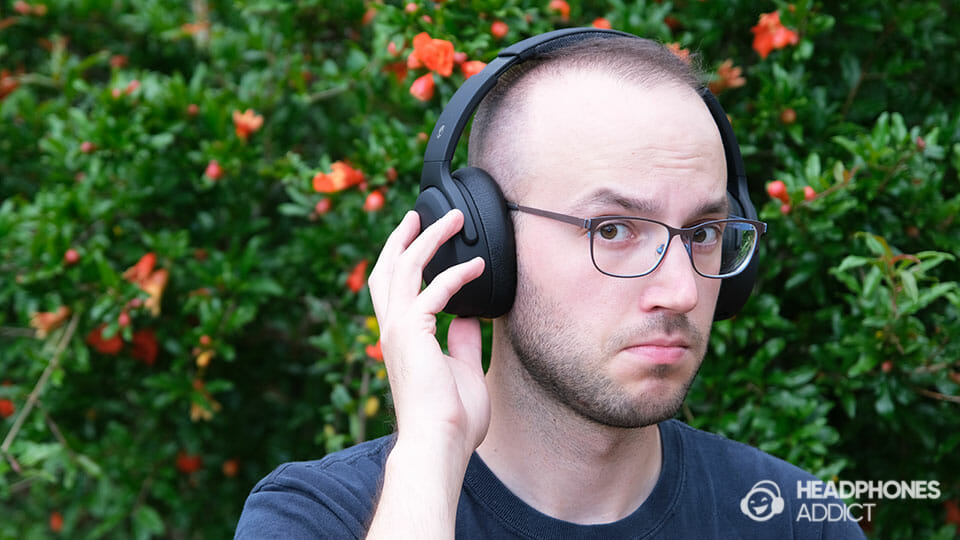
Bluetooth 2.0
A year after, in November 2004, SIG announced Bluetooth 2.0, which extended the wireless range up to 100 feet (30 meters) and improved the transfer speed to 2.1Mbps using the new features called Enhanced Data Rate (EDR).
Bluetooth 2.1
The update from August 2007 added support for Near Field Communication (NFC) and a more secure and faster pairing process called Simple Secure Pairing (SSP).
- Faster transfer speeds & lower power consumption than Bluetooth 1.0.
- Still not good enough to ensure good audio listening experience (low quality and high latency).
Bluetooth 3.0
Bluetooth 3.0, released in April 2009, introduced the High-Speed (HS) feature, which used a Wi-Fi connection to transfer data at much higher speeds than before. It ranged from 800kbps to 24Mbps.
However, the HS protocol only worked on supported Bluetooth devices that also had a Wi-Fi module, like laptops and mobile phones, leaving the headphones out. The latter were still stuck with 2.1-3Mbps speeds.
- Much improved data transfer speeds meant faster data sharing.
- Headphones still suffered from poor audio quality.
Bluetooth 4.0
Released in December 2009, Bluetooth 4.0 represented a big leap in short-range wireless connectivity. It brought numerous improvements and useful features:
- Increased connection range of 200 feet (60 meters).
- Improved data transfer up to 24Mbps (with EDR).
- Low Energy or “Bluetooth Smart” mode with speeds up to 1Mbps, ideal for small IoT (Internet of Things) devices.
- Smarter pairing and re-pairing process.
- Bluetooth multipoint for connecting and switching between multiple devices simultanously.
- Improved connection stability and data transmission thanks to Adaptive Frequency Hopping (AFH).
- Support for Bluetooth codecs like aptX.
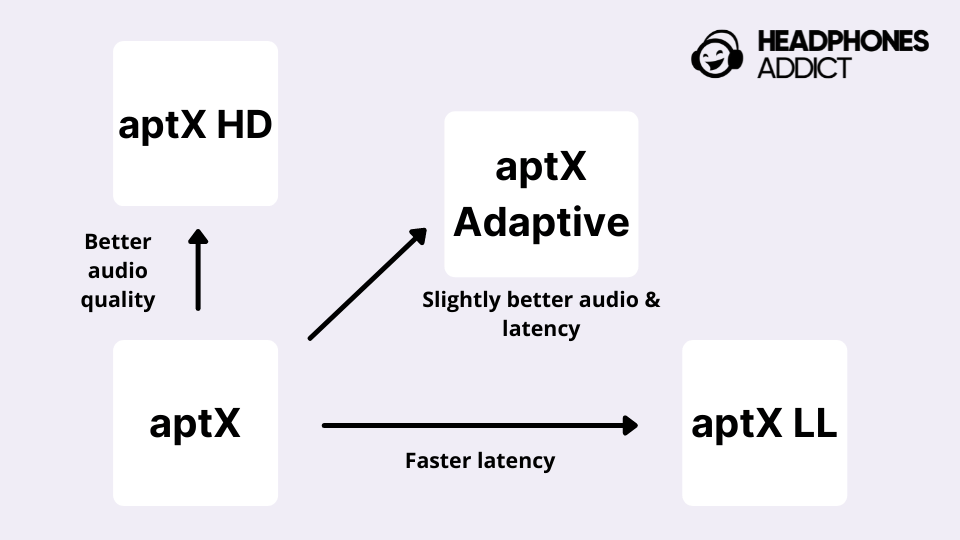
Bluetooth 4.1
In December 2013, version 4.1 improved the connectivity between multiple IoT devices and increased the speed with EDR to 25Mbps, strengthened connection stability, and added AES encryption to boost security. This version is also able to direct IPv6 traffic.
Bluetooth 4.2
A year after, version 4.2 further improved connectivity between IoT devices by adding Internet Protocol Support Profile (IPSP).
- Higher data speeds, lower energy consumption, and the addition of aptX meant higher audio quality.
- Still some connection issues in a room full of other wireless devices.
Bluetooth 5.0
In July 2016, Bluetooth 5.0 was another big update, bringing nifty features like:
- Increased Bluetooth range up to 800 feet (240 meters).
- Double the data transfer speed over the previous generation with 2Mbps (LE) and 50Mbps (EDR).
- Even better IoT connectivity and energy efficiency.
- Dual Audio for sending audio signal to two devices simultaneously.
- More resilient connection to other wireless technologies like LTE and Wi-Fi.

Bluetooth 5.1
Bluetooth 5.1 was released in January 2019, and it brought more accurate directional connectivity. By using more than one antenna, it can more accurately predict the location of the Bluetooth device, sending the signal directly rather than all around, thus saving energy.
Bluetooth 5.2
In December of the same year, Bluetooth 5.2 introduced a successor to the SBC codec, the LC3, and with it, the Low Energy Audio (Bluetooth LE Audio).
Bluetooth 5.3
The July 2021 update mostly improved the connection stability and efficiency, resulting in lower energy consumption.
Bluetooth 5.4
The latest February 2023 update enables to connect multiple low-power end nodes to a single access point while maintaining bi-directional communication. It also provides security and power efficiency improvements.
How Quality is Audio Transmitted via Bluetooth?
The sound quality via Bluetooth depends on the Bluetooth codec that’s in use. But the usual rule is that the higher the bit rate, the better the sound quality.
Here’s a quick comparison between different Bluetooth codecs and their audio quality:
| Low Bit Rate | Max Bit Rate | Bit Depth | Max Freq. | Latency | |
|---|---|---|---|---|---|
| SBC | 192 kbit/s | 328 kbit/s | 16-bit | 48 kHz | Bad 200ms |
| AAC | 128 kbit/s | 320 kbit/s | 16-, 24-bit | 44.1 kHz | Bad 200ms |
| LC3 | 160 kbit/s | 392 kbit/s | 16-, 24-, 32-bit | 48 kHz | Good |
| aptX | 352 kbit/s | 384 kbit/s | 16-bit | 48 kHz | Average <180ms |
| aptX LL | 384 kbit/s | 384 kbit/s | 16-bit | 44.1 kHz | Best <50ms |
| aptX HD | 576 kbit/s | 576 kbit/s | 16-, 24-bit | 48 kHz | Bad 200ms |
| aptX Adaptive | 279 kbit/s | 420 kbit/s | 16-, 24-bit | 48 kHz | Good 80ms |
| LDAC | 330 kbit/s | 990 kbit/s | 16-, 24-bit | 96 kHz | Bad 200ms |
| LHDC | 400 kbit/s | 900 kbit/s | 16-, 24-bit | 96 kHz | Bad 200ms |
| LHDC LL | 400 kbit/s | 600 kbit/s | 16-, 24-bit | 48 kHz | Best 30ms |
| Samsung Scalable | 88 kbit/s | 512 kbit/s | 16-, 24-bit | 96 kHz | n/a |
Remember that both the mobile device and the headphones need to support the Bluetooth codec you want to use.
SBC – First and most common is SBC or sub-band codec that is mandatory to be included in all Bluetooth-supported headphones and speakers (with A2DP profile). It offers reasonable audio quality at average bit rates and low processing demands.
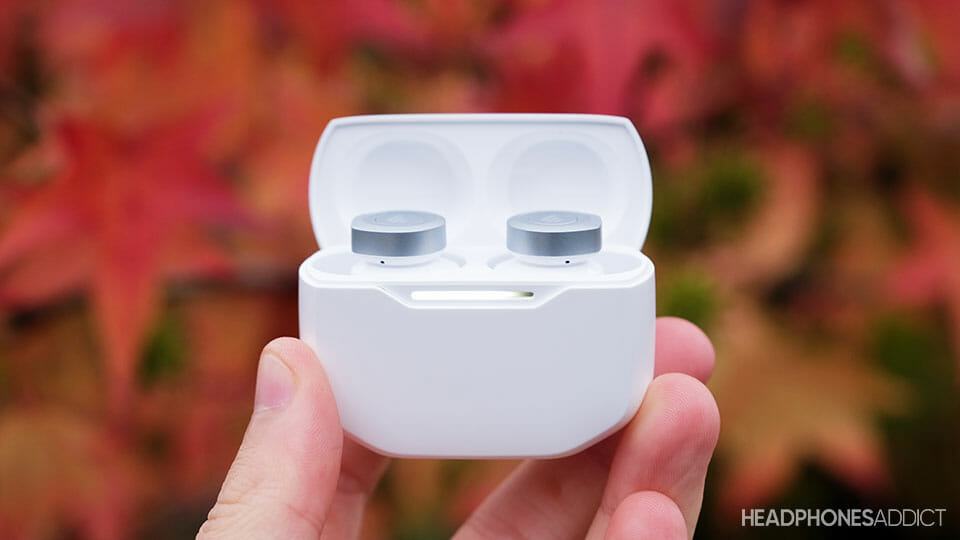
AAC (Advanced Audio Coding) – It’s an audio coding international standard for digital compression with some loss in quality (replacement for MP3). iOS devices like iPhones offer better sound with AAC than Android phones because of how battery functions are programmed.
aptX – This is a family of Bluetooth codecs made by a giant Qualcomm that improves overall wireless Bluetooth connectivity. These are probably the most popular non-mandatory codecs. They consist of the:
- aptX codec
- aptX Low Latency (aptX LL)
- aptX HD
- aptX Adaptive
- aptX Lossless
LDAC – It’s made by Sony, has a variable bit rate, and is now supported on most Android devices (after Oreo). LDAC is capable of high-resolution audio wireless transmission with a small loss in quality.
Samsung Scalable – A rather obscure Bluetooth codec that’s only supported on Samsung devices and headphones.
LHDC – A high-quality audio codec similar to the LDAC in terms of maximum bitrate. However, it’s only supported by a few Asian smartphone brands and wireless headphones.
However, note that in most cases, you can’t tell the difference between Bluetooth audio codecs.
Things that matter more than codec are:
- How DSP processes the sound
- How well the amp boosts the signal without creating too much harmonic distortion
- How well DAC converts the audio data to the analog signal
- How good is the driver/transducer that produces the sound
How Did Bluetooth Get Started?
The short-range radio technology, later named Bluetooth after King Harald Bluetooth was initially developed in 1989 in Sweden.
It was released to the market in 1999 as the Bluetooth 1.0. And the first Bluetooth mono headset was displayed in the same year at the convention. Learn more about the history of Bluetooth.

The Bluetooth Special Interest Group (Bluetooth SIG) oversees the development of Bluetooth standards and gives licenses to manufacturers to use the technology in their products.
What was the first pair of Bluetooth headphones?
While the first mono wireless headsets originate in 1999, nobody really knows what the first Bluetooth headphones were. According to the official Bluetooth page, they were released in 2004.
Nonetheless, wireless Bluetooth headphones became a practical option in the 2010s and a popular option a couple of years ago (with efficient Bluetooth codecs).
What are the previous limitations of Bluetooth that have been improved over the years?
The biggest limitation was the sound quality and audio delay.
Sound quality – when transmitting audio via Bluetooth, you need to encode the data before sending it over to the receiving device. However, due to data transfer limitations, encoding algorithms heavily compress the data, also cutting away from the redundant one to keep the data size small. Basically, audio over Bluetooth is always lossy and compressed, even with Bluetooth 5.3, but it was worst in earlier versions.
Delay – audio needs to go through numerous processing, from ADC, encoding, transmitting, decoding, DSP, DAC, and amp, which inevitably introduces some delay. With optimizations in how devices communicate with each other, newer Bluetooth versions display a much lower delay.

What is the Next Frontier in Bluetooth Headphone Technology?
In the future, we can expect better lossy Bluetooth codecs that will deliver a near CD-like sound quality. Plus better power management system will prolong the battery life of Bluetooth devices.
At the moment listening to music wirelessly takes away from the audio quality, which you can hear if you have a trained ear and the right equipment.
Even though most people can’t detect the difference, test yourself here.
Maybe, they’ll figure out how to make a lossless Bluetooth codec though these are just audiophile dreams at the moment.
Frequently Asked Questions (FAQ)
Is Bluetooth 6 out?
No, Bluetooth 6 isn’t out, and it isn’t even announced yet. SIG have just released Bluetooth 5.4 in 2023, is it might take a few years before getting version 6.0.
Is Bluetooth 5.4 available?
Bluetooth 5.4 was released in February 2023 is will soon arrive in consumer and industrial devices.
What can Bluetooth 5.2 do?
Bluetooth 5.2 introduced LE Audio (Low Energy) and the LC3 audio codec, which provide higher audio quality and enhanced power control. It also offers isochronous channels to switch between devices and even tunes to a different audio source from a TV without affecting the other watchers.
Conclusion
Each Bluetooth generation brings valuable security, energy efficiency, and stability improvements. However, audio quality remains mostly the same unless it’s a major update (like from Bluetooth 4.0 to 5.0).
Therefore, unless you want to have better connection stability, you don’t have to chase the latest Bluetooth versions.
What Bluetooth headphones to pick?
We make and constantly update lists of the best headphones in the market. We’re sure you’ll find some that perfectly fit your needs.

From a childhood fascination with sound, Peter’s passion has evolved into a relentless pursuit of the finest headphones. He’s an audio expert with over 5 years of experience in testing both audiophile and consumer-grade headphones. Quote: “After many years, I can confidently tell which headphones are good and which are terrible.” Find his honest opinion in his reviews.


